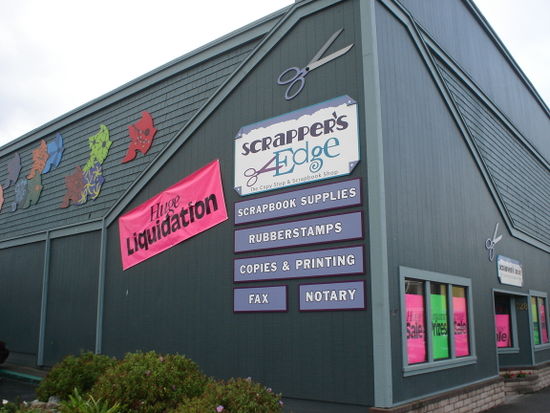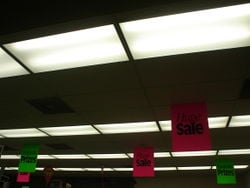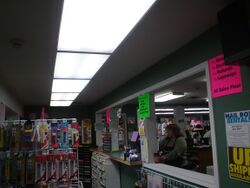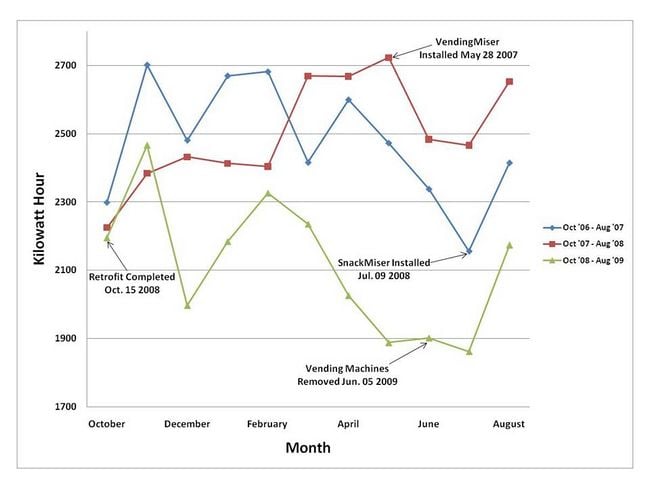Anonymous1 (talk | contribs) |
|||
| Line 34: | Line 34: | ||
=== Energy Use Reduction === | === Energy Use Reduction === | ||
RCEA estimated that after the lighting retrofit Scrapper's Edge would reduce its energy use by 7,790 kWh/year,<ref name="projectsummary"></ref> but in the year after the retrofit Scrapper's Edge has only reduced its energy use by 4,120 kWh (Table 1 shows data for Energy Use Reduction). According to Lou Jacobson, Auditor of RCEA, RCEA calculated the baseline wattage per existing fixture or set of fixtures, then did the same for each fixture that would be installed during the proposed retrofit. In order to find projected energy savings Lou subtracted the kWh use of the proposed fixture installation from the kWh use of the existing fixtures. The actual reduction of energy use was calculated by averaging the kWh energy use per year for the two years prior to the retrofit and comparing it to the kWh energy use of the year after the retrofit. According to Sondra Kirtley, Scrapper's Edge has not added any new appliances since the retrofit, has not changed their lighting use habits, or the building's insulation in any way, and the businesses' operating hours have remained the same. Scrapper's Edge used to have two vending machines prior to the retrofit and eight months into the year after the retrofit. The vending machines were removed during June of 2009, with the exception of this most of the business' energy use has remained constant before and after the retrofit.<ref name="interviewsondra"></ref> The vending machines that were in the store would have affected the kWh energy use per year but it has not been determined by how much. | RCEA estimated that after the lighting retrofit Scrapper's Edge would reduce its energy use by 7,790 kWh/year,<ref name="projectsummary"></ref> but in the year after the retrofit Scrapper's Edge has only reduced its energy use by 4,120 kWh (Table 1 shows data for Energy Use Reduction).<ref name="scrappersedgedata">Jacobson, L. (2009). Scrapper’s Edge Use Data : Provided by Redwood Coast Energy Authority. Retrieved Via e-mail from Dustin Poppendieck</ref> According to Lou Jacobson, Auditor of RCEA, RCEA calculated the baseline wattage per existing fixture or set of fixtures, then did the same for each fixture that would be installed during the proposed retrofit. In order to find projected energy savings Lou subtracted the kWh use of the proposed fixture installation from the kWh use of the existing fixtures. The actual reduction of energy use was calculated by averaging the kWh energy use per year for the two years prior to the retrofit and comparing it to the kWh energy use of the year after the retrofit. According to Sondra Kirtley, Scrapper's Edge has not added any new appliances since the retrofit, has not changed their lighting use habits, or the building's insulation in any way, and the businesses' operating hours have remained the same. Scrapper's Edge used to have two vending machines prior to the retrofit and eight months into the year after the retrofit. The vending machines were removed during June of 2009, with the exception of this most of the business' energy use has remained constant before and after the retrofit.<ref name="interviewsondra"></ref> The vending machines that were in the store would have affected the kWh energy use per year but it has not been determined by how much. | ||
<br /><br /><br />'''Table 1. Data for Energy Use Reduction''' | <br /><br /><br />'''Table 1. Data for Energy Use Reduction''' | ||
{| class="wikitable" | {| class="wikitable" | ||
Revision as of 23:22, 10 December 2009

Scrapper's Edge
Scrapper's Edge, as pictured in Figure 1, is located in Eureka, California. Owned and operated by Sondra Kirtley, Scrapper’s Edge provides the local community with art and craft supplies. In addition to paper crafting and art supplies, Scrapper’s Edge provides copy and printing services, computer rental and scanning stations, UPS Shipping, and an array of paper crafting classes.[1] Scrapper’s Edge was contacted by Redwood Coast Energy Authority (RCEA) to provide the business with energy retrofit suggestions. The first retrofit that was carried out at Scrapper’s Edge by RCEA, was the implementation of vending machine controllers. The controllers would reduce the amount of energy consumed by the snack and soda machines that were located on the premises of the business. Sometime after the first energy retrofit, RCEA contacted Ms. Kirtley again with the suggestion to have another energy assessment performed. This time the energy assessment would be of the businesses’ lighting. Ms. Kirtley went ahead with the energy assessment because she knew if she could reduce the store’s overall energy consumption she would see the savings reflected in her monthly energy statement. The business owner also acknowledges that her businesses’ energy use has an impact on the environment and would like to play a role in reducing that impact. [2]
RCEA Retrofits
Redwood Coast Energy Authority performed both a vending machine retrofit and a lighting retrofit at Scrapper's Edge. The first retrofit that was carried out by RCEA was the installation of a vending machine controller in May of 2007, and later an additional controller was installed during July of 2008.[3] Lastly, RCEA performed an energy assessment during September of 2008 and a lighting retrofit during October of that same year.[4]
Vending Machine Retrofit
One of the first retrofits suggested by RCEA to the store owner was to add a device to the vending machines located at the business called a VendingMiser/SnackMiser.[5] Scrapper’s Edge previously had vending and snack machines that increased the business' energy consumption. The VendingMiser could potentially reduce the machines consumption of energy by an average of forty-six percent.[6] Ms. Kirtley went ahead with the installation of the VendingMiser and SnackMiser, but eventually removed the machines from the business after the energy controllers were installed. Below in Figure 4, are labels that outline the installation and removal of the Vending/SnackMisers and the vending machines prior to and after the retrofit. Ms. Kirtley did notice a reduction of energy usage in her monthly bill compared to the time before the vending machine controllers were installed, but felt that the vending machines were not producing enough profit to make up for energy costs.


Lighting Retrofit
In September 2008 RCEA performed an energy assessment of the 6,500 square foot store[1] and completed an energy retrofit during October of that same year. The retrofitting process involved RCEA evaluating the business' energy usage and then finding methods to reduce their overall energy consumption. According to Lou Jacobson, Auditor of RCEA, the goal is to reduce excess foot-candle or ambient lighting, and either increase or maintain task lighting. A majority of the lighting in the store is task lighting. Most of the task lighting is located in the crafting area where classes take place and in the side room that connects to the instructional area. Currently, the primary energy consumers at Scrapper’s Edge are the copy machines, computers, and lighting. Sondra worked with an electrician that she has contracted before to carry out the RCEA retrofit. The electrician removed 78 magnetic lighting ballasts[7] and replaced them with nearly the same amount of electronic ballasts. The old magnetic ballasts housed 40 watt T12 tubes (1.5 or 12/8 inch tubular fluorescent) shown in Figure 2, and the newly installed electronic ballasts house 32 watt T8 tubes (1 inch tubular fluorescent)[8] pictured in Figure 3. The magnetic ballasts were changed out with newer electronic ballasts that are more energy efficient. The Lighting ballasts and fluorescent tubes that were replaced are located in the instructional area, side room, copy and cashier area, restrooms, and kitchen. The entire installation took about a week to be completed and was performed during business hours. A small portion of ballasts were not replaced, but the owner would like to eventually retrofit the remaining lighting;[2] the lights that Ms. Kirtley would like to eventually replace are pictured in Figure 3.
Incentives for Retrofitting
RCEA provides businesses with a list of contractors who will perform the retrofits at a low cost which reduces the overall cost of the installation, or the business can request a contractor that they generally work with. Furthermore, RCEA researches and applies for rebates in which the business' retrofit qualifies for. Ms. Kirtley said RCEA took care of all the paper work for the rebates so it was no hassle to her. The rebates diminish the overall cost for the business owner, which in turn reduces the payback time of funds invested by the owner toward the retrofit.
Retrofit Analysis
After analyzing Scrapper's Edge energy billing information that was provided by the store owner, it was discovered that RCEA's predictions of energy use, energy bill, and Carbon Dioxide emissions reductions were not achieved. Additionally, the retrofit payback period estimated by RCEA did not match the actual results. RCEA's payback period was predicted to be 1.4 years, and the actual payback period was found to be 4.2 years.[4]
Energy Use Reduction
RCEA estimated that after the lighting retrofit Scrapper's Edge would reduce its energy use by 7,790 kWh/year,[4] but in the year after the retrofit Scrapper's Edge has only reduced its energy use by 4,120 kWh (Table 1 shows data for Energy Use Reduction).[9] According to Lou Jacobson, Auditor of RCEA, RCEA calculated the baseline wattage per existing fixture or set of fixtures, then did the same for each fixture that would be installed during the proposed retrofit. In order to find projected energy savings Lou subtracted the kWh use of the proposed fixture installation from the kWh use of the existing fixtures. The actual reduction of energy use was calculated by averaging the kWh energy use per year for the two years prior to the retrofit and comparing it to the kWh energy use of the year after the retrofit. According to Sondra Kirtley, Scrapper's Edge has not added any new appliances since the retrofit, has not changed their lighting use habits, or the building's insulation in any way, and the businesses' operating hours have remained the same. Scrapper's Edge used to have two vending machines prior to the retrofit and eight months into the year after the retrofit. The vending machines were removed during June of 2009, with the exception of this most of the business' energy use has remained constant before and after the retrofit.[2] The vending machines that were in the store would have affected the kWh energy use per year but it has not been determined by how much.
Table 1. Data for Energy Use Reduction
| AVERAGE ENERGY USE | |
|---|---|
| Prior to Retrofit | 29,766 kWh/year |
| Post Retrofit | 25,646 kWh/year |
| Actual Reduction Post Retrofit | 4,120 kWh/year |
| Estimated Reduction Post Retrofit | 7,790 kWh/year |

Energy Bill Reduction
RCEA estimated that after the lighting retrofit Scrapper's Edge energy bill would reduce by $1,299.04/year.[4] In the year following the retrofit, Scrapper's Edge had only seen a savings of $437.24 reflected in their bill (Table 2 shows data for Energy Bill Reductions). RCEA calculated the energy bill reduction by multiplying their estimated kWh/year reduction by their estimated cost rate of $0.16676/kWh.[4] As a small business, Scrapper's Edge electric rate is based on an A1 Schedule. According to Pacific Gas & Electric (PG&E)[10] (the energy provider for Scrapper's Edge) the A1 rate, which is the price per kilowatt-hour (kWh) that a business is charged, has increased since the time the retrofit estimates were made. The average energy bill cost rate prior to the retrofit was $0.16695/kWh and the average energy bill cost rate after the retrofit was $0.17524/kWh.[10] This single cent per kWh increase cost added $217.48 to the energy bill of the year after the lighting retrofit. Because the estimated energy bill savings per year differs from the actual energy bill savings per year more than $217.48/year (there is a $861.80 difference between the estimated and the actual); it is assumed that the difference between the estimated and the actual is due to the difference in the estimated kWh use reduction and the actual kWh use reduction.
Table 2. Data for Energy Bill Reductions
| AVERAGE ENERGY BILL | |
|---|---|
| Prior to Retrofit | $4,780.71/year |
| Post Retrofit | $4,343.47/year |
| Actual Reduction Post Retrofit | $437.24/year |
| Estimated Reduction Post Retrofit | $1,299.04/year |
Carbon Dioxide Emissions Reduction
RCEA estimated that after the lighting retrofit Scrapper's Edge would reduce its Carbon Dioxide (CO2) Emissions by 4,050 lbs/year,[4] but in the year after the retrofit Scrapper's Edge has only reduced its CO2 Emissions by 2,158 lbs (Table 3 shows data for Carbon Dioxide Emissions Reductions). Both calculations were done the same way: Multiply the kWh used per year by 0.524 lbs of CO2 per kWh.
[11] The only factor making the estimated reduction different from the actual reduction is the kWh use, which is discussed above.
Table 3. Data for CO2 Emissions Reductions
| AVERAGE CO2 EMISSIONS | |
|---|---|
| Prior to Retrofit | 15,597 lbs/year |
| Post Retrofit | 13,439 lbs/year |
| Actual Reduction Post Retrofit | 2158 lbs/year |
| Estimated Reduction Post Retrofit | 7,790 lbs/year |
Simple Payback
The total cost of the retrofit installation was $3,821.56. The rebates that were applied to the lighting retrofit minimized the overall cost for Sondra Kirtley by $1,987.67,[4] leaving the owner with less than forty-eight percent of the remaining cost. Ms. Kirtley's portion for the installation came out to be $1,833.89. The breakdown of the cost to each party can be seen in Table 4. RCEA estimated that after the lighting retrofit Scrapper's Edge would save enough money in their monthly energy bill to recuperate the money that was invested in the installation within 1.4 years.[4] According to the actual savings that are reflected in the business' monthly energy bills, it will take about 4.2 years to recover the money that was invested by Sondra Kirtley. Additionally as shown in Table 4, there is also an estimated simple payback time of 7.5 years had Ms. Kirtley not received a rebate on the lighting retrofit.
Table 4. Breakdown of Overall Lighting Retrofit Cost & Simple Payback Time
| TOTAL INSTALLED COST | INSTANT REBATE | OWNER'S FINAL COST | |
|---|---|---|---|
| Cost | $ 3,281.56 | $ 1,987.67 | $ 1,833.89 |
| PREDICTED | ACTUAL WITH REBATE | WITHOUT REBATE | |
| Simple Payback | 1.4 years | 4.2 years | 7.5 years |
Owner's Feedback Regarding Retrofit
Sondra decided to participate in the retrofit for several reasons; she felt it was the right thing to do from an environmental standpoint, that it would save her business a significant amount of money. Simply put Sondra said the project was a "no-brainer." Sondra mentioned that RCEA was a great organization to work with, and overall they were efficient and helpful. The owner believes that the retrofit was worthwhile and very satisfying. Since the retrofit Sondra has seen a reduction in energy and cost reflected in her monthly bill, and believes the lighting is somewhat brighter in her store. Had RCEA not approached Sondra with the proposal to retrofit her business, she wouldn't have know about the process and potential savings. Although Sondra has yet to do so, she would like to recommend this retrofit to other businesses.[2]
References
- ↑ 1.0 1.1 Scrapper’s Edge. Retrieved October 17, 2009, from Scrapper’s Edge Official Site Website: http://www.scrappersedge.net/About.html
- ↑ 2.0 2.1 2.2 2.3 Interview with Sondra Kirtley Owner of Scrapper's Edge. Interview October 19/21, 2009
- ↑ E-mail exchange with Lou Jacobson of RCEA. Recieved October 21, 2009
- ↑ 4.0 4.1 4.2 4.3 4.4 4.5 4.6 4.7 Jacobson, L.(2009). Redwood Coast Energy Authority: Project Summary- Lighting Customer Report. Retrieved Via e-mail from Dustin Poppendieck
- ↑ Vending Miser. Retrieved October 26, 2009, from Vending Miser Official Online Store: http://www.vendingmiserstore.com/?gclid=CP2j7Z_m0Z0CFRQpawodLCD9tA
- ↑ Redwood Coast Energy Watch. Retrieved October 26, 2009 from Redwood Coast Energy Authority Official Site: http://redwoodcoastenergyauthority.org/node/2
- ↑ What is a Lighting Ballast? Retrieved October 26, 2009 from Wise Geek Official Site: http://www.wisegeek.com/what-is-a-lighting-ballast.htm
- ↑ Jacobson, L. (2009). Redwood Coast Energy Authority: Measures & Schedules: Audit #463. Retrieved via e-mail from Lou Jacobson
- ↑ Jacobson, L. (2009). Scrapper’s Edge Use Data : Provided by Redwood Coast Energy Authority. Retrieved Via e-mail from Dustin Poppendieck
- ↑ 10.0 10.1 Pacific Gas & Electric: Electric Rates. Retrieved October 17, 2009 from Pacific Gas & Electric Official Site: http://www.pge.com/nots/rates/tariffs/electric.shtml
- ↑ RCEA energy audit reviews. Translating the Use History Workbook and other Notes. Retrieved October 17, 2009 from Appropedia website: http://www.appropedia.org/Category:RCEA_energy_audit_reviews